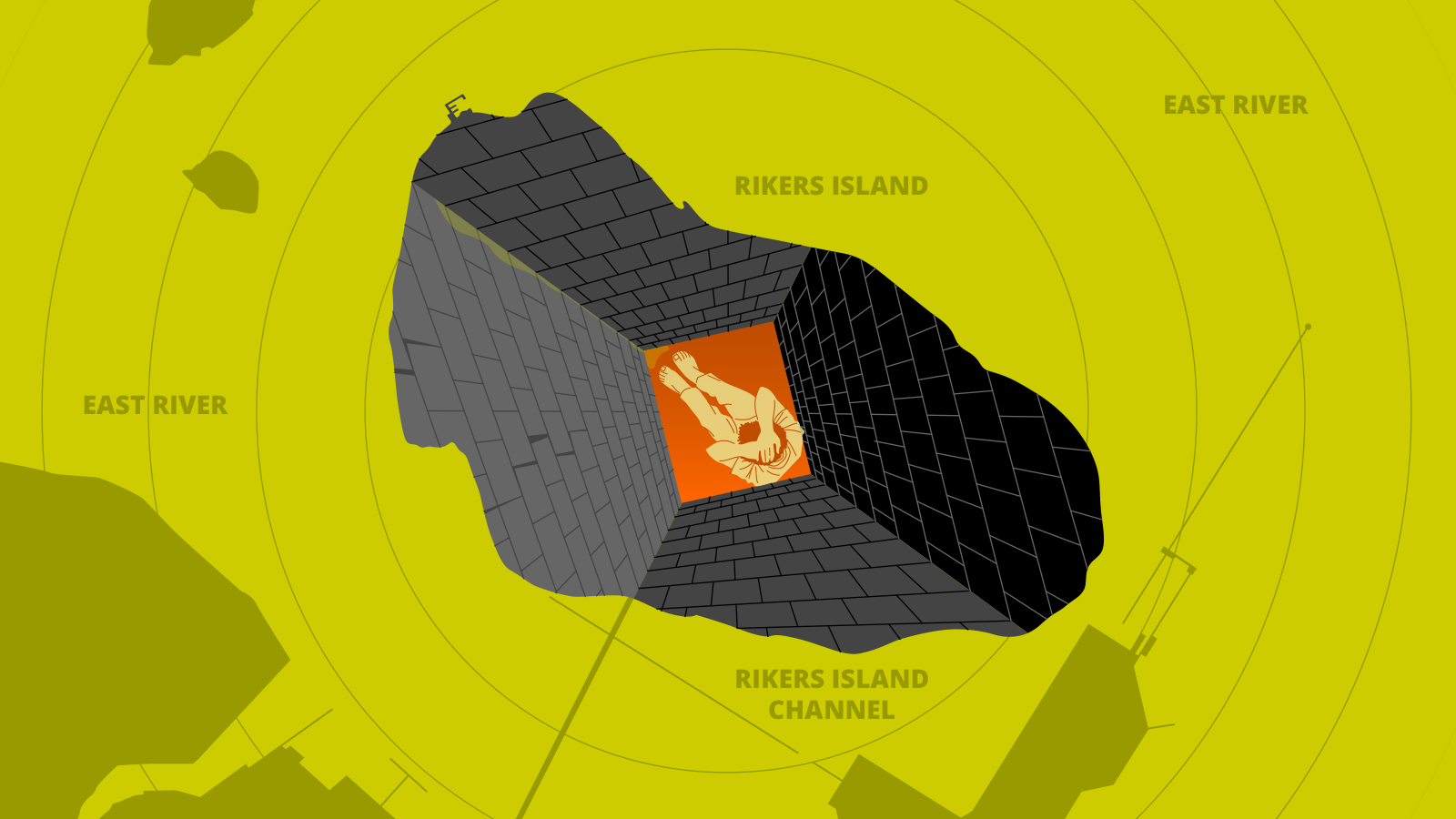There’s a known stench on Rikers Island in the New York summertime. Neither the people incarcerated there, nor the correction officers working there, can escape it. “The smell alone would torture you,” says Candie Hailey-Means, who was incarcerated at Rikers until May 2015. “It smells like sewer, mixed with fertilizer, mixed with death.”
Hailey-Means was sent to Rikers on Feb. 22, 2012, when she was 28 years old. Six weeks after her arrival, Hailey-Means was sent to solitary confinement after an incident with one of the guards. (Hailey-Means says the guard assaulted her but she was written up for assaulting the guard.) She spent two years and three months in solitary, locked in a 6-by-10-foot cell for 23 to 24 hours a day. A small slot in the door, where she would receive meals, was her only connection to the outside world.
Hailey-Means’ mental and physical health quickly deteriorated. Her treatment by guards and the intolerable conditions in solitary confinement — complete isolation, extreme temperatures, polluted air, the stink of the landfill — led Candie to try to take her own life. About two weeks after being locked in “the bing” (the colloquial term for solitary), Hailey-Means first tried to drown herself in her toilet bowl. The suicide attempts continued from there: swallowing Nair, saving medication for a week to take all at once, cutting her wrists. There were more than eight attempts in total.
Hailey-Means described the summer heat in solitary as unbearable. She developed heat rashes, and cited the high temperatures as part of the environment that led her to attempt suicide: “Imagine being stuck in an elevator for three years and the temperature is [unbearably] hot.”
Her story is just one of many over the past two years that illustrates the harrowing conditions at the Rikers Island multi-jail complex in New York City. Media outlets like The New York Times have documented the violence and human rights issues in multiple investigations. While the overall amount of violence is down from historical highs in the ’90s, 2015 had the highest numbers for both guard-on-inmate use-of-force and inmate-on-inmate violence in the past five years.
The problems at Rikers tend to overwhelmingly afflict certain groups of people, too. About 40 percent of the Rikers population has been diagnosed with a mental illness. And the overwhelming majority of the people incarcerated on the island — about 90 percent — are black or Latino.
To further complicate matters: The vast majority of people detained at Rikers have not been convicted of a crime. Some, like Hailey-Means, will have to wait years before going to a trial. For those who have been convicted, they’re carrying out short-term sentences for low-level offenses.
Footage of Rikers when it was a large landfill operation in 1903.Library of Congress
On Dec. 18, 2014, Preet Bharara, the U.S. attorney for the Southern District of New York, announced the Justice Department’s plan to sue New York City due to the abuse of inmates on Rikers Island. (The lawsuit was consolidated with a 2011 class-action lawsuit filed by the Legal Aid Society.) Mayor Bill de Blasio announced a number of reforms in 2015, including the addition of Enhanced Supervision Housing units and daily violence prevention programs. The Board of Correction also implemented reforms on solitary confinement that reduced the number of people held there.
It’s the abuse and violence at Rikers that have received the most attention. But there’s another dimension to the ongoing disaster there: the dangerous environmental conditions. Rikers is built on a landfill. The ground underneath the facilities is unstable and the decomposing garbage emits poisonous methane gas. In addition to extreme heat and poor air quality, flooding and crumbling infrastructure pose a serious threat, especially when superstorms like Hurricane Sandy strike. As the violence and human rights violations worsen, so do the environmental circumstances surrounding Rikers.
Inside Rikers Island
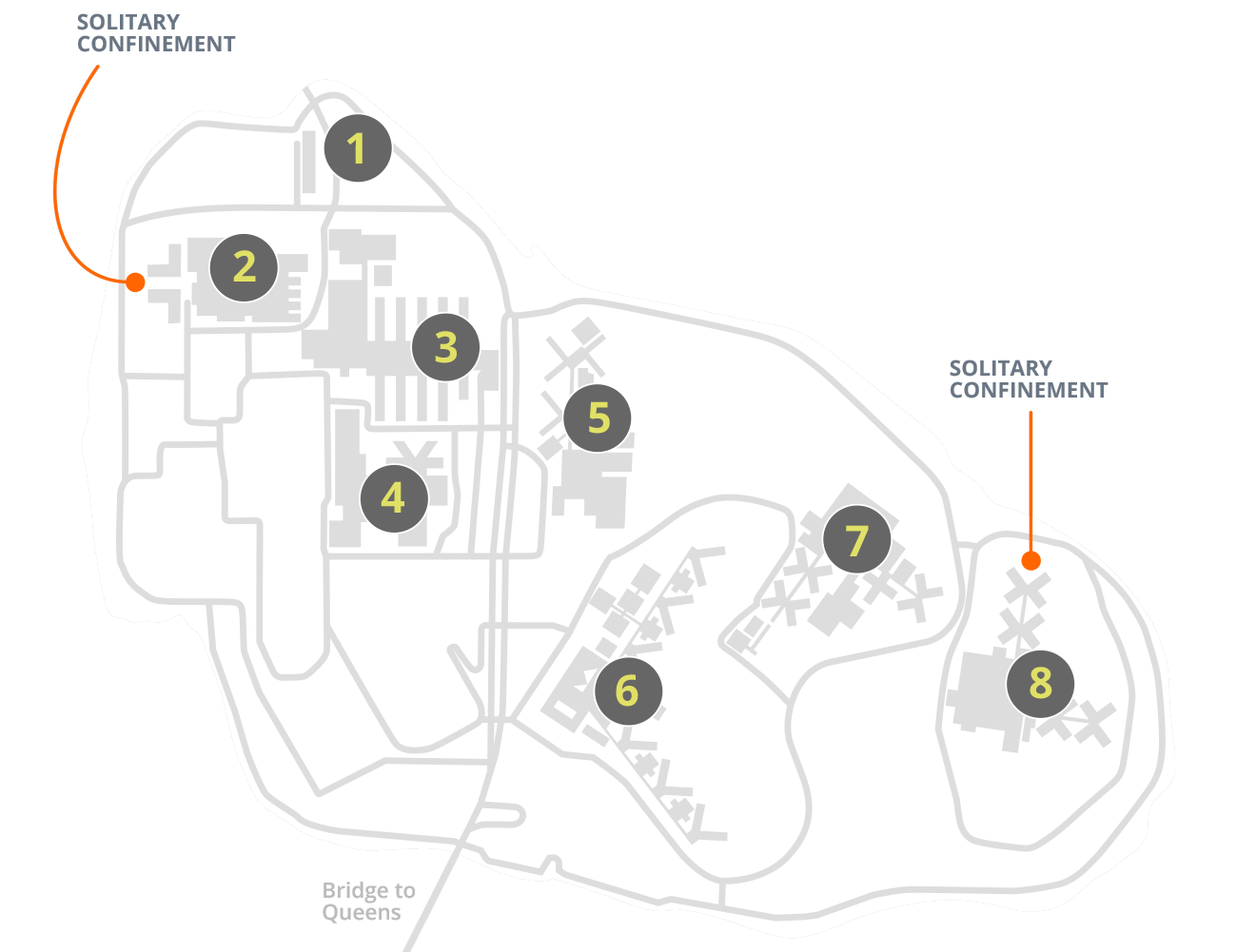
1. Power plant
Rikers has its own power plant. In 2014, the plant released 127 million pounds of CO2 emissions. A more efficient co-generation plant began operating in the beginning of 2015.
2. Otis Bantum Correctional Center
The 400 solitary units in OBCC are not air conditioned. In 2013, a doctor called the temperature situation at Rikers “a serious health threat.”
3. North Infirmary Command
Houses mostly sick inmates. The unit only recently got air conditioning.
4. Anna M. Kross Center
The largest jail on Rikers has more than 2,000 beds. Complaints of flooding at AMKC were sent to the Legal Aid Society in 2015.
5. George Motchan Detention Center
Has more than 2,000 beds and houses most of Rikers’ 18 to 21 year-olds. Complaints of flooding were sent to the Legal Aid Society in 2015.
6. Robert N. Davoren Center
Has a unit for 16 to 17 year-olds. The violence in the adolescent unit was the subject of a federal report written by U.S. Attorney Preet Bharara in 2014. Flooding has damaged the adolescents’ school, gym, and library.
7. Rose M. Singer Center
Has a unit devoted to women. Candie Hailey-Means was incarcerated here.
8. George R. Vierno Center
Has 150 air-conditioned solitary cells. Damaged underground pipes often cause sewage backups and water shutoffs.
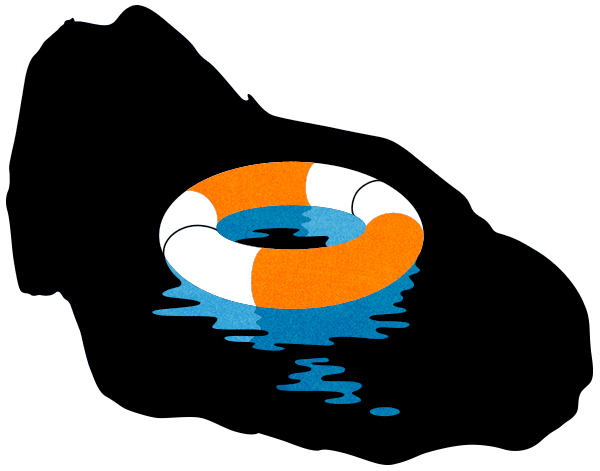
1. When it rains outside, it rains inside.
With the anticipation of Hurricane Sandy, everyone was nervous. Hailey-Means recalls the guards and detainees worried about being trapped on the island. Family members of the people incarcerated on the island expressed their concerns in news reports.
On Oct. 28, 2012, then-Mayor of New York City Michael Bloomberg announced the city’s evacuation plan, which included a mandatory evacuation order for low-lying areas like Coney Island, Red Hook, the Rockaways, and coastal portions of Staten Island. One part of the city was missing from the plan altogether: Rikers Island.
Projected 100-year flood and 500-year flood zones paint a troubling picture. The jail complex, which holds between 7,800 and 10,000 people, sits on a 415-acre island in New York’s East River, between the Hunts Point neighborhood of the Bronx to the north and LaGuardia Airport to the south. “Rikers is vulnerable to flooding. Each storm comes in differently and it depends on direction of storm and timing of high tides,” says Mark Cranston, the former New York City Department of Correction chief of staff.
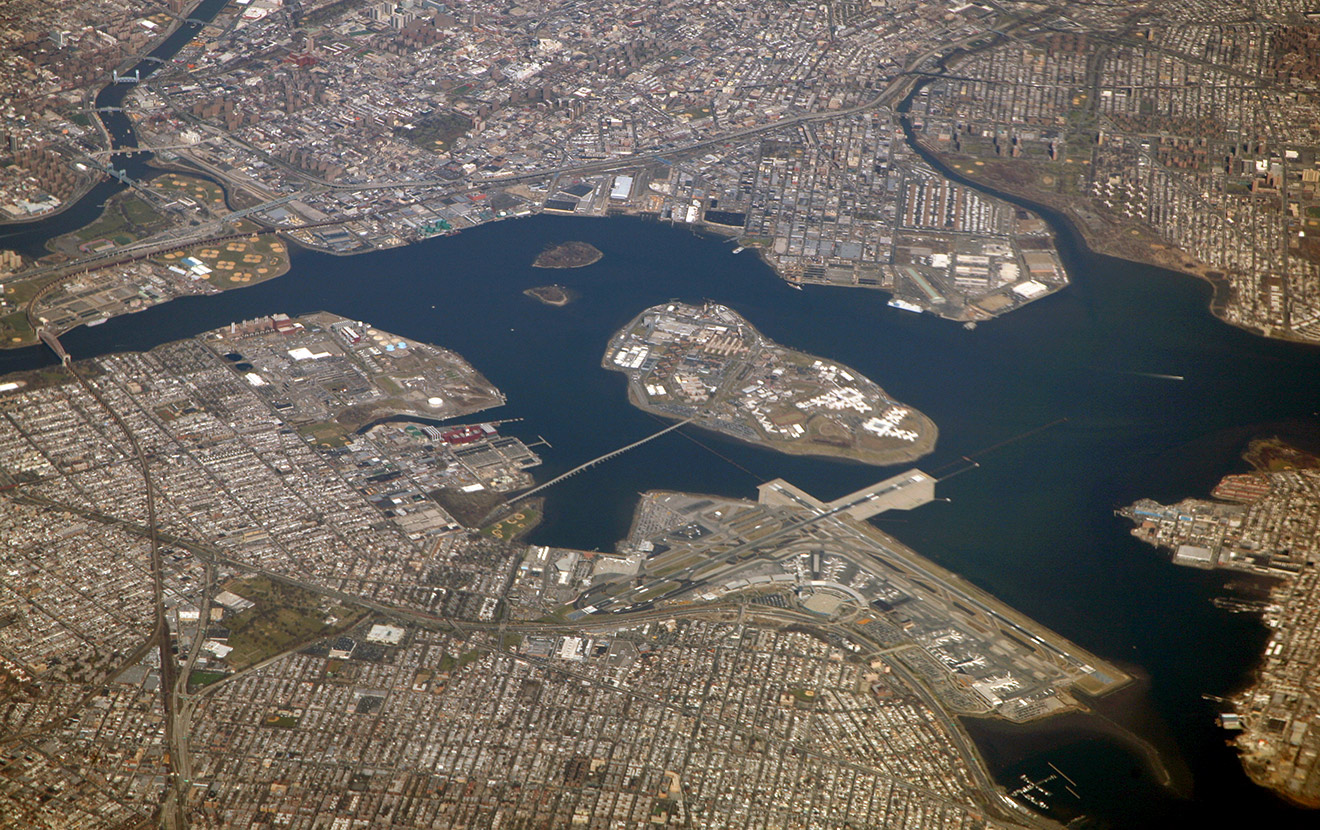
Aerial view of Rikers Island with LaGuardia airport in the foreground.Doc Searls
After the storm hit, the DOC’s then Deputy Commissioner for Public Information Matthew Nerzig told Mother Jones that there were no power outages and that there was no significant flooding. However, the significance of the flooding is open to interpretation. According to multiple sources, including city Comptroller Scott Stringer (who mentioned it at a panel discussion in November 2015) and people incarcerated at Rikers at the time, there was enough flooding to cause damage.
Flooding occurred in the Robert N. Davoren Center, one of the 10 jails on the island that houses detainees. One of the recreational gyms was damaged and wasn’t repaired until over a year later. The northwest part of the island flooded, too, including a main road that leads to the urgent care facility. Errol Jackson, who was incarcerated in the Anna M. Kross Center during Hurricane Sandy, admits there was minimal flooding in the dormitory area, but says water did seep into some people’s cells.
It’s true that the damage to Rikers wasn’t extensive. However, Sandy’s impact brings up a major question: How will the island fare in future natural disasters? When bigger, stronger hurricanes and snowstorms strike? A year earlier, during Hurricane Irene, The New York Times revealed that the Department of Correction did not have a full evacuation plan for Rikers Island — or even a plan to evacuate the population in buildings prone to flooding. An official who works high-up in the city’s jails said this is still the case. While the DOC is in the habit of moving detainees off the island who need consistent medical care, it had no plan for evacuating the whole population.
One problem is that there is only one way on and off the island, a narrow bridge from Queens. In January 2016, during a snowstorm, one inmate eventually died from a suicide attempt after an ambulance was delayed by the storm.
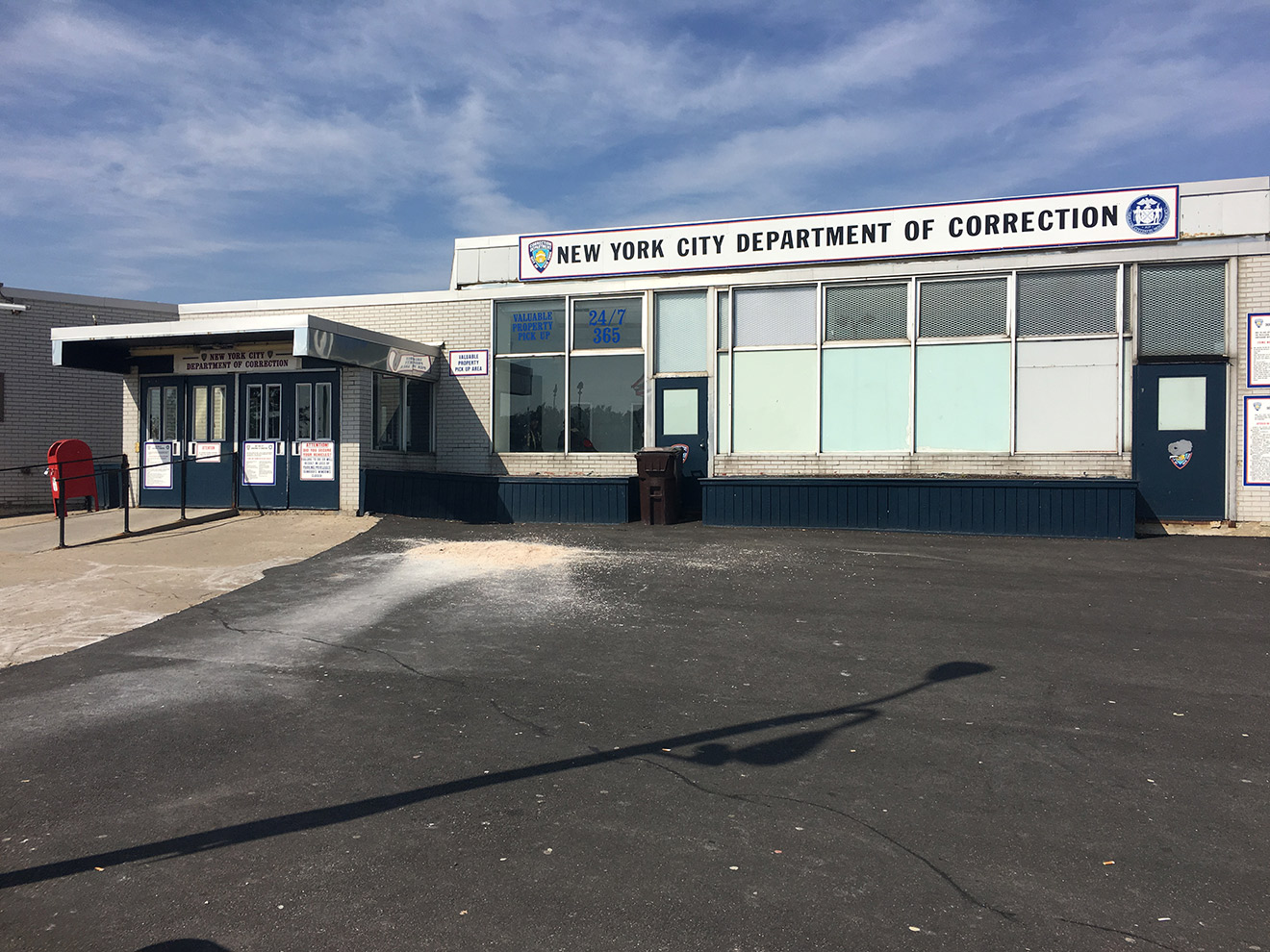
The entrance to Rikers.Grist / Raven Rakia
Even in the absence of a natural disaster, buildings on Rikers Island flood during regular rain and snowfalls, mainly due to the facility’s dilapidated state. According to interviews with people incarcerated there and experts’ reports, the jail complex is falling apart: cracks in the surfaces and foundation of buildings, peeling paint, missing floor and wall tiles, corroded metal walls, damaged doors, and broken window screens. Since the beginning of 2015, the Legal Aid Society has received complaints of flooding from people being held in the Robert N. Davoren Center (RNDC), Anna M. Kross Center, George Motchan Detention Center, Rose M. Singer Center, and the Otis Bantum Correctional Center.
In particular, the RNDC has had a consistent flooding problem that still persists today. In the October 2015 Board of Correction meeting, board member Robert Cohen noted, “The library in RNDC was a dedicated space named in honor of a child of a correction officer who died young. It flooded five years ago [and] it’s been flooded continuously since then. It was flooded when I visited two weeks ago.” The flooding regularly stops the teenage detainees from using the library. According to Board of Correction member Bryanne Hamill, who discussed the issue at the March 2016 meeting, the roof of the school in RNDC is also currently leaking.
One nonprofit advocate, who asked to remain anonymous, recalls a guard saying this about RNDC: “When it rains outside, it rains inside.”
The crumbling infrastructure at Rikers leads to more than flooding. The majority of weapons found on the island (about 79 percent in 2014) are fashioned out of building materials at hand, and not smuggled in. Makeshift wooden or metal shanks can be made from fragments of deteriorating windows, floors, and radiators. The slashings on the island today are much lower than the historic high (1,552 slashings in 1990, compared to 131 in 2015). However, 2015’s number is still the highest in the past 10 years, even as the population on Rikers continues to decline.
A Department of Correction spokesperson responded: “The [de Blasio] administration’s capital investments since the FY16 executive budget have moved the department forward with the necessary infrastructure modifications so needed at both DOC on-island and off-island facilities. A key plank of the 14-point anti-violence reform agenda is to raise DOC facilities to a state of good repair to ensure safety of staff and inmates alike.”
The easy access to weapons creates paranoia among the people incarcerated there. “You never know when something is going to happen to you,” says Kenny Bianco, a 50-year-old chef and poet who’s been incarcerated at Rikers over a dozen times. He recalled an incident at Rikers where he saw one man, suffering from a mental illness, slash another man multiple times on his face. Then, turning the knife on himself, he began to cut himself as well. According to Kenny, the guards didn’t do anything for 20 minutes.
The violence “is always there,” says Omar Smith, who was incarcerated at Rikers at age 20, “whether or not you want to avoid it.”
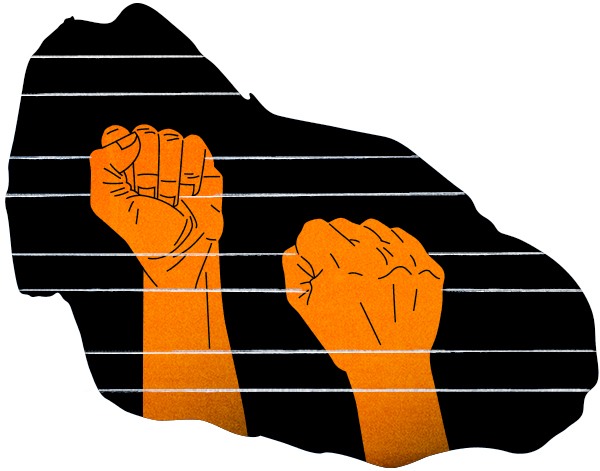
2. The Oven
The Oven is Rikers Island’s nickname.
Last September, a 26-year-old man currently incarcerated at the Otis Bantum Correctional Center on Rikers admitted that he tried to start a riot, an act that got him 30 days of solitary confinement. (He asked to remain anonymous out of fear of retaliation for speaking to the press.) “I lost my cool. There’s only so much you can take,” he told me. “It [was] 95 degrees and there’s no central air here. We call it the oven.”
The concrete floors, steel doors, and cinder block walls of the cells in Rikers absorb the outside temperature, and there’s little relief in the areas without air conditioning.
“When it’s cold outside it’s even colder inside, and when it’s hot outside, it’s even hotter inside,” says Johnny Perez, who was last detained on Rikers in 2011 and is now a re-entry advocate with the Urban Justice Center, a nonprofit that helps low-income New Yorkers with legal problems.

Johnny Perez (center) at a rally by the Campaign to Shut Down Rikers.Ashoka Jegroo
In June 2013, detainees interviewed by the Legal Aid Society described a summer of horror that was similar to Hailey-Means’ experience. Consistent, extreme heat affected their mental and physical health.
All of the detainees who wrote to the judge expressed that temperatures felt like 100 degrees or higher in the summer months. Freddie McGrier, who was being held in solitary at the time, said in a signed affidavit to the court that the cells were 10 degrees hotter than outside: “It has been extremely hot in CPSU [the Central Punitive Segregation Unit]. In my cell, it feels like it’s 104 degrees in my cell when it’s 94 degrees outside. I feel like I’m dying in the cell. I have a heart murmur and my heart will start pumping hard. I get dizzy and get migraine headaches from the heat.”
Multiple people expressed that they often were denied taking a cold shower and had no access to cold water to drink. Guards reportedly retaliated against them if they complained or advocated for themselves. One detainee, Carvett Gentles, said his cell “feels like an oven” and that he woke up with his clothes and bed sheets drenched in sweat. During a heatwave in the summer of 2013, he fainted.
Another detainee said that the heat exacerbated his asthma: “In my cell, it feels like I am dizzy. My asthma starts getting worse and I have been short of breath.” The statements are part of a larger class-action lawsuit on the heat conditions at Rikers that has been ongoing since 1975. (Yes, you read that correctly — the suit has been in litigation for over 40 years.) The Legal Aid Society and the Department of Correction are currently in settlement talks regarding the lawsuit.
In August 2013, Susi Vassallo, mandated by a court order, conducted temperature monitoring on Rikers Island. Vassallo is an associate professor of emergency medicine at the NYU School of Medicine. She has studied and monitored extreme temperatures in Texas’ state prisons, which have come under fire after having over a dozen heat-related deaths since 2007, as well as Mississippi and Louisiana, states that were awash in lawsuits from their heat-related issues on death row.
Vassallo called the temperature situation at Rikers “a serious health threat” and “unsafe for inmates.” She also said that the ventilation system on Rikers was not adequate. Not only did the vents not work in multiple cells and entire tiers, sometimes it actually blew out hot air, driving some detainees to cover their vents altogether. (Vassallo declined to comment for this piece due to what “may or may not be legal proceedings.”) Currently, the Department of Correction is under court order to fix the ventilation systems.
Vassallo concluded in her letter to the judge, “The temperatures in the cells of Rikers punitive segregation” — aka solitary confinement — “and the temperatures in the cells in Texas weather differ by very few degrees in summer months … It should not be necessary for a Rikers inmate to die of a heat stroke to prove the hottest days in New York summers are equally life threatening to inmates in Rikers as those in Texas. Cardiovascular diseases worsen in such temperatures, and death rates in individuals with underlying diseases increase in hot temperatures.”
And hot temperatures are on the rise. Last year saw 19 days of 90-plus degree temperatures in New York City. In 2010, there were 36 90-plus degree days. That number is only expected to increase. The New York City Panel on Climate Change projected that by 2080, the frequency of heatwaves in the city will triple. A 2013 study published in Nature Climate Change projected a 20 percent increase in heat deaths by the 2020s, with that percentage further doubling by the 2080s.
“Extreme heat can cause direct harmful health effects like heat stroke, heat fainting, heat rash but it also makes a whole range of common ailments [worse] like heat-related illnesses, respiratory illnesses … breathing ailments like asthma or COPD [chronic obstructive pulmonary disorder],” says Kim Knowlton, a senior scientist at the Natural Resources Defense Council.
The DOC currently has a plan to place people with physical or medical conditions (e.g., someone with a heart condition) in air-conditioned units when the temperature outside rises above 85 degrees. However, John Boston of the Legal Aid Society has stated that it has received complaints from people, designated as heat-sensitive, who have not been moved into air conditioning. Having asthma alone is not enough for someone to be marked heat-sensitive.
According to Knowlton, even a healthy person can face permanent or even lethal consequences when the body core temperature hits 105 degrees. “Heat stroke is an absolutely serious life-threatening condition,” she says. “People die from it and people who survive after having heat stroke can have long-term effects [such as] diminished neurological effects or more sensitivity to the heat … If inmates can’t say, ‘I need to change what I’m doing right now’ and get into air conditioning … they are really at risk.”
Air conditioning isn’t exactly flowing at Rikers, either. In total, six of the 10 jails on Rikers do not have air conditioning, and the other jails are only partially air-conditioned. At the start of 2015, the DOC did install air conditioning in 150 punitive segregation cells in the George R. Vierno Center. However, in the Otis Bantum Correctional Center, the young adult population (18- to 21-year-olds) in solitary confinement is still held in a unit without air conditioning.

Top row, L-R: Views of the upper tier in MHAUII for adolescents at GRVC. “ADOL” refers to adolescents. Each door has a “slot” through which food is delivered to prisoners. It also functions as a cuffing port, through which prisoners must place their hands for handcuffing before they exit their cell. Bottom row, L-R: The interior of a typical punitive segregation cell in CPSU; a toilet, sink/water fountain, and mirror in a typical cell; a view down the tier in the Restricted Housing Unit (RHU) at RNDC.The City of New York Board of Correction
Those incarcerated at Rikers say the heat adds tension during the summer months. “It felt like hell has risen,” says Gerald R., who was incarcerated at Rikers when he was 19 years old. Errol Jackson agrees: “The tensions get up real fast because [it’s hot].” Fights among detainees are more likely to break out, as well as conflicts between detainees and guards.
The heat sometimes results in protest. On occasion, detainees have refused to lock in their cells during count in the morning or afternoon, or after nine in the evening — when they have to be locked in for the night. “Sometimes [the detainees] tell [the guards], ‘we not locking in because it’s too hot,’” Jackson says. Such refusal has often meant calling in the Emergency Services Unit, the jail version of a riot squad. Referred to as “the turtles” by some detainees, the ESU is known to use extreme force when bringing people back to their cells. During and after the protests, detainees are threatened with solitary confinement.
Jackson was detained on Rikers for over two years and was just released in January. He describes the conditions as “just crazy. I wouldn’t wish that on my worst enemy,” adding that his environment sometimes made him depressed.
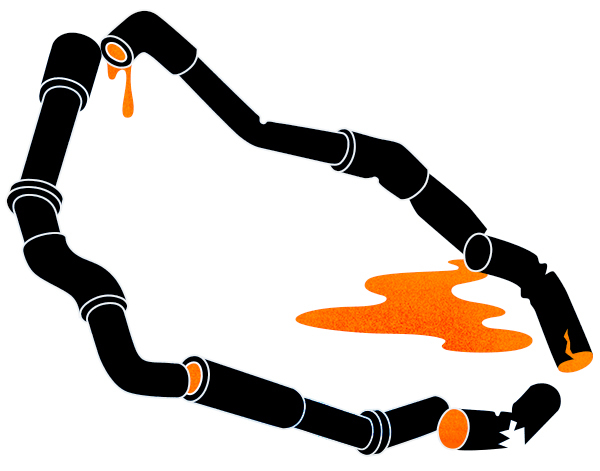
3. Stinking and Sinking
The jails on Rikers Island are built on a landfill. In 1884, the Commissioner of Charities and Corrections bought Rikers Island for $180,000 in order “to build a bigger jail,” as The New York Times headlined it two years later. At the time, the penitentiary on Roosevelt Island was overcrowded and nearly double its capacity. Rikers Island was only 87.5 acres, so for the next couple decades, the city used prison labor to expand the island with ash and garbage to more than 400 acres. In 1935, the House of Detention for Men, the first penitentiary on Rikers Island, opened.
Today, the smells emanating from the landfill are unbearable. “Sometimes, it smells like straight rotten eggs,” says Jackson.
The foul odors are just the beginning of the air quality issues at Rikers. The landfill underneath burps methane, a noxious gas, as the garbage decomposes naturally. Less than a mile away in Queens sit five power plants that spew volatile organic compounds and nitrogen oxide, a pollutant. The Poletti power plant, infamous for being the biggest polluter in New York, sat within a mile of Rikers and operated until 2010 when it closed due to community pressure. (Since then, two power plants have replaced it.) On the other side, within a mile, sit four waste transfer stations and a compressor station in the Bronx. The island is also home to a power plant that provides energy for the jail facility.
[protected-iframe id=”dda6b46bfddeb3c58a2f1a721efebb4c-5104299-66535714″ info=”https://ravenrakia.cartodb.com/viz/ba9ef30a-e4b9-11e5-9d38-0e5db1731f59/embed_map” width=”100%” height=”520″ frameborder=”0″ webkitallowfullscreen=”” mozallowfullscreen=”” allowfullscreen=””]
This map shows the location of sites contributing to air pollution on or around Rikers Island, including power plants, waste transfer stations, and natural gas compressor stations.
Documents obtained by Grist show that the power plant on Rikers emitted 8,650 pounds of a dangerous pollutant, PM2.5 (solid airborne particles that are 2.5 microns or smaller) and 9,435 pounds of PM10 (10 microns or smaller) in 2014. One of the operating power plants within a mile from Rikers has had at least 13 violations of the Clean Water Act or the Clean Air Act in the past 10 years.
Along with power plants, waste transfer stations (like the ones nearby in the Bronx) are also known for a high amount of particulate matter emissions due to the high number of trucks emitting diesel exhaust. Particulate matter is linked to many short-term and long-term health effects such as increased risk of asthma attacks, dying from lung cancer, and heart attacks, according to the American Lung Association. Exposure to it is even worse for people with asthma or heart disease, the elderly, and children.
In short, it’s hard to breathe on or around Rikers. Around 10 percent of the people incarcerated at Rikers Island have asthma and this figure doesn’t include the prison staff on the island, which is subject to the same polluted air.
Omar Smith, who was incarcerated at Rikers in 2014, where he suffered from bad asthma attacks, told Grist, “At one point, I was coughing and spitting up blood.” Hailey-Means developed asthma while on Rikers and now uses an inhaler two to five times a day.
Jackson sometimes felt that fumes from the landfill, along with the uncontrollable amount of dust inside his housing area, contributed to his asthma acting up. In fact, dust was cited by five of the people interviewed for this story as a major issue at Rikers. The “screens are caked with dust,” says Revern Sharp, who was incarcerated at Rikers in 2011.
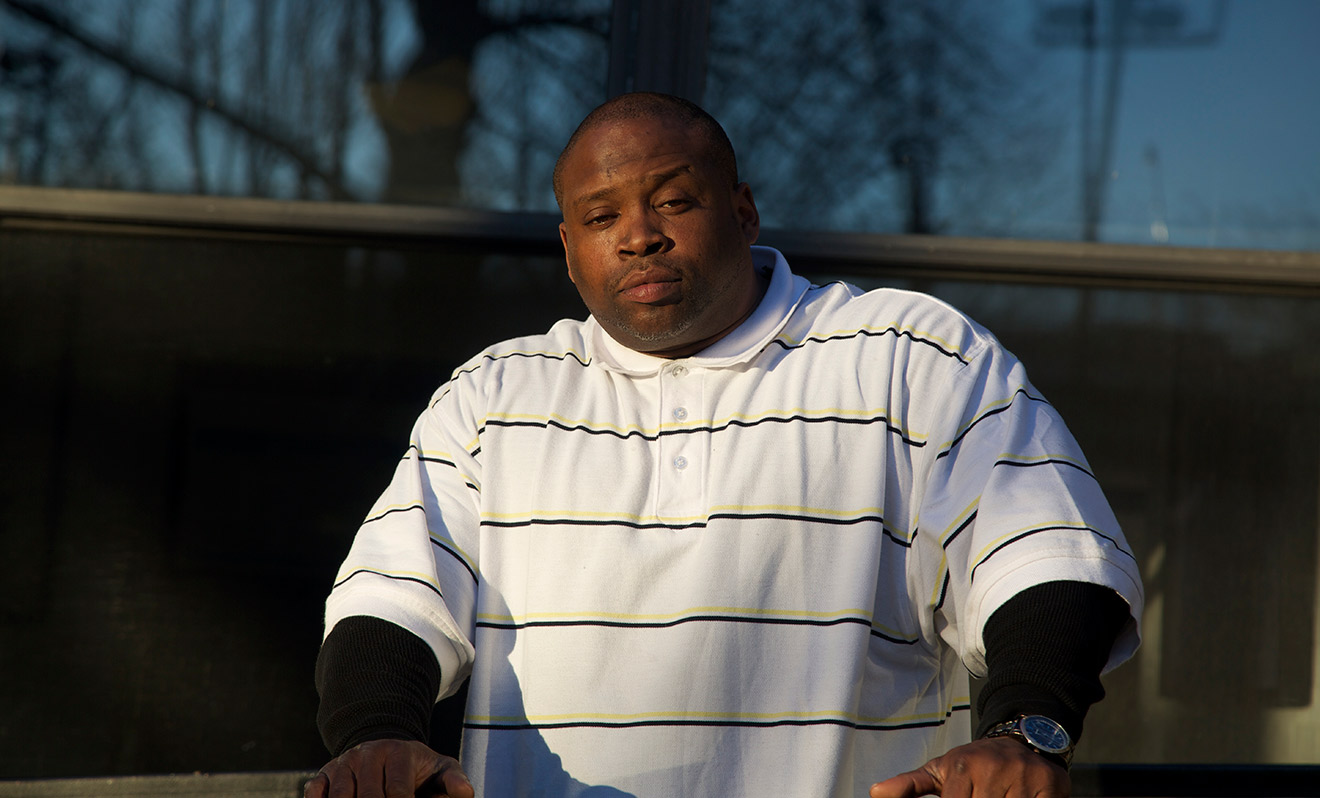
Revern Sharp.Grist / Raven Rakia
The power plant on Rikers Island also spews greenhouse gases into the atmosphere. In 2014, the amount of yearly carbon emissions on the island was 127.1 million pounds (or 63,550 tons). A spokesperson from the DOC said that a cogeneration plant that began operating in January 2015 resulted in carbon emissions being reduced by about a third. (Open records requests for the island’s 2015 carbon emissions were not granted.)
The methane emanating from the landfill is also a greenhouse gas, though a methane detection system installed in 1990 on new constructions does help monitor the gas. The landfill poses a secondary threat, however: instability beneath Rikers’ foundation.
When garbage decomposes, it creates pockets of air in the ground. “Anything that is biodegradable creates pockets in the dirt,” explains Heath Suddleson, a project manager with over 30 years of professional construction experience, including building a number of jails and prisons. The air pockets result in ground settlement.
What exactly is ground settlement? Suddleson compares it to a common instance on the beach: Imagine standing right at the water’s edge and letting the tide wash over your feet. When the tide starts to retreat, the water pulls away some of the sand beneath your feet and you ever so slightly begin to sink. That sinking feeling is the ground settling around your feet.
As air pockets pop up beneath Rikers, the ground sinks and shifts to fill the gaps. All this sinking and shifting is unpredictable, and the ground settlement threatens the very foundation of the building. “[The ground] does not shift or sink in a uniform way,” says Suddleson. “So for a building that large, only say, a corner of the building will have ground underneath it that goes down and that corner will go down with it.” The result is cracks in the walls or ceilings of the building, which adds to the flooding issue.
Ground settlement also causes problems with the water supply. The water pipes are located underground, and as the ground shifts the pipes can move, crack, or break apart.
In 2004, Martin Horn, then the DOC commissioner, discussed the issues of Rikers’ ground settlement in a Board of Correction meeting: “Rikers Island … has been expanded by landfill and is unstable. There are more structures than it can support … In some cases the weight of buildings bear down upon pipes. These factors, when combined with unstable soil structure, result in ‘settling’, which leads to cracked pipes.”
That some of the pipes were not laid down properly just exacerbates the issue. In the 1990s, during the height of the drug war, the jail population was growing exponentially. To house the growing population, the city began building new facilities hastily and adding water pipes haphazardly, with some lying directly on top of others.
When pipes break administrators at Rikers will often have to shut down the water or sewage systems until the pipes are fixed. These water outages can last 24 to 80 hours. Usually during this time, toilets and showers are inaccessible and drinking water is cut off. In certain cases sewage and draining backups result in flooding, which happened in at least two jail facilities over the past year: the Anna M. Kross Center and the Otis Bantum Correctional Center.
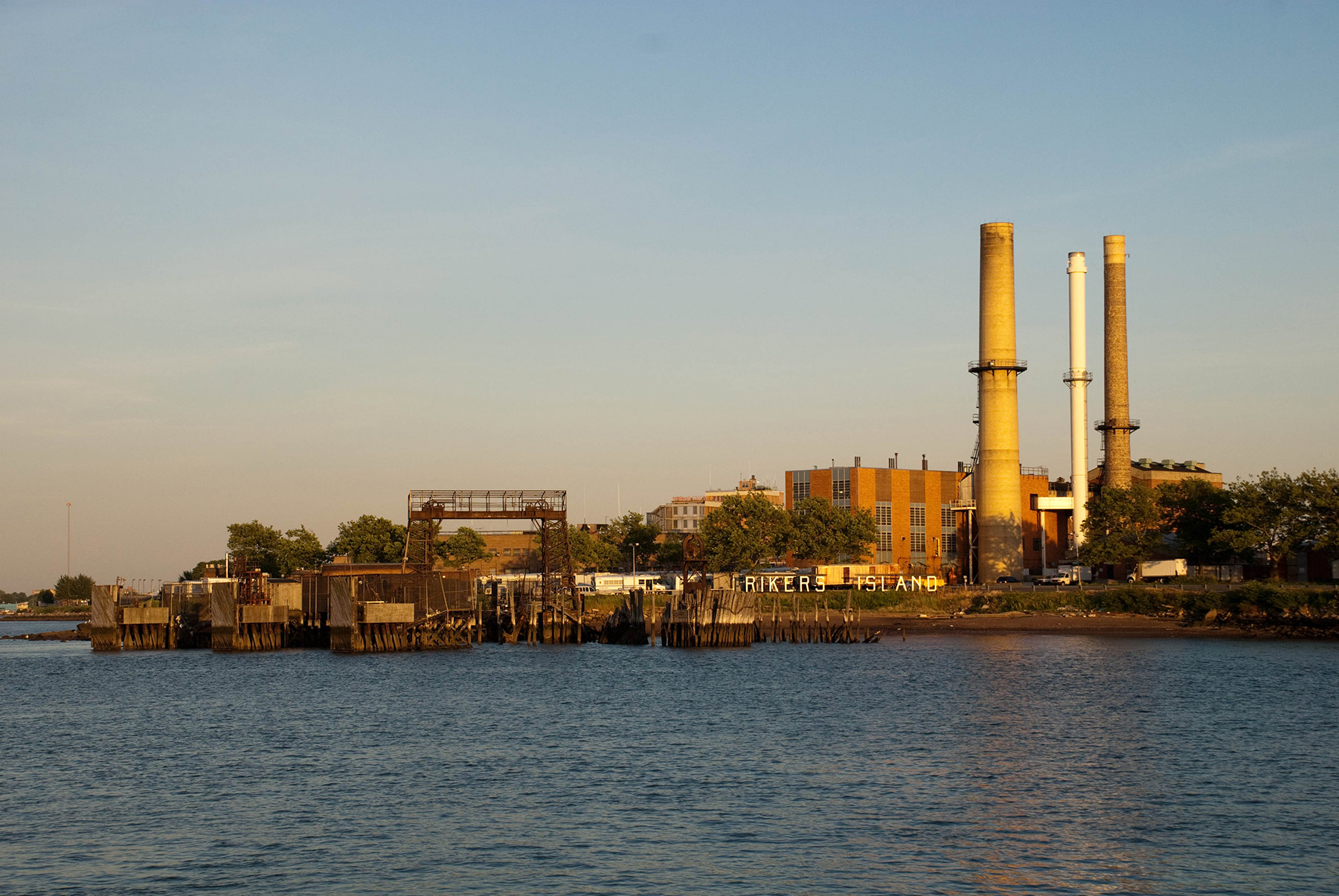
The power plant on Rikers Island.Norman Walsh
The George R. Vierno Center (GRVC) has “a notorious problem under building five,” according to Mark Cranston. “The pipes that all run under there, there’s no rhyme or reason to them. They frequently back up. I think they’re pitched improperly underground so it doesn’t allow for [proper] water flow [which results in flooding]. There’s sewage backups [that also result in] flooding and some of the flooding is related to pipes bursting under the building.” The issue at GRVC, a newer building, exemplifies the larger issue at Rikers. Even with newer infrastructure, the landfill will continue to undermine the foundation of the facilities.
Gerald R., who was incarcerated in GRVC, said that water shutoffs “were the most horrible thing to deal with.” Gerald R. recalls the thirst and hunger during water shutoffs being overwhelming. The only escape he found was sleep.
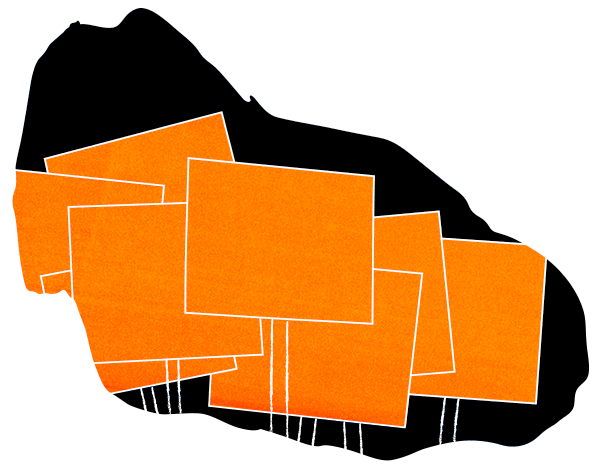
4. Shut the Whole Thing Down?
Mayor Bill de Blasio continues to call for reform on Rikers Island, and the city has allocated more than $200 million for future infrastructure upgrades. Other local politicians, however, view the current facility as a lost cause, and are asking: Should Rikers Island be shut down?
When Melissa Mark-Viverito, speaker of the New York City Council, gave her State of the City speech in February, she said she was creating a commission to find ways to lower the population on the island — in order to reach the eventual goal of closing the facility down. Gov. Andrew Cuomo followed by saying that shutting Rikers was a great idea, calling it “intriguing.” Mayor de Blasio, however, has said the idea wasn’t feasible — citing expensive costs to build new jails.
The Department of Corrections has acknowledged that a lot on the jail needs fixing. In 2015, the DOC released a 14-point anti-violence plan. One of the initiatives was to “raise facilities to a state of good repair.” Without much detail, the DOC states the plan will involve renovating current facilities and demolishing facilities beyond repair. Still, in a 2015 interview with the Marshall Project, DOC Commissioner Joseph Ponte stated: “The maintenance hasn’t kept up the condition of the physical plant. We do have more money today for renovation, but you can’t rehab a housing unit with inmates in it.”
Money will certainly be a determining factor in the fate of Rikers. City Comptroller Scott Stringer released a study in 2015 showing that the cost per inmate, $112,665, is the highest it’s been in three decades. In November, Stringer called for the jail to be closed, citing poor infrastructure and the cost of keeping it open.
Some advocates want Rikers closed, too, but more for moral reasons than financial ones. “Any criminal justice effort in New York City that falls short of closing Rikers amounts to a blatant disregard for the needs of communities that have been ravaged by this factory of despair,” says Glenn Martin from JustLeadership USA. JustLeadershipUSA is part of a coalition of more than a dozen advocacy groups that are pressuring lawmakers in Albany to shutter Rikers. Since Rikers is a jail — i.e., a short-term facility for both people awaiting trial and minor offenders — the length of stay for many detainees depends on how long their due process takes. Martin and others argue that the judicial process needs as much repair as Rikers itself.
“In order to reduce the number of residents enough to close Rikers, we must reduce inexplicably lengthy court delays and enact meaningful bail reform,” says Martin. He wants to see a system of localized, neighborhood jails — instead of one, behemoth clearinghouse — and an investment in communities.
There are currently jails off Rikers Island in Brooklyn, Manhattan, and the Bronx, but they all come with a host of their own poor conditions. New neighborhood jails will likely be costly and politically difficult since council members tend to not want new jails in their districts.
However, the Campaign to Shut Down Rikers, a group of activists and formerly incarcerated people, argues that new jails wouldn’t be necessary. What they’re calling for instead is a divestment from mass incarceration, along with an end to bail, and an investment in health care, living wage jobs, and mental health treatment that would lead to safer communities. For starters, moving the 40 percent of the population that suffers from a mental illness to a treatment center would reduce the jail population significantly.
“We’re pouring money into an archaic structure, when we should be asking how we can reduce the population in order to close it,” says Johnny Perez of Urban Justice Center. “The problem with Rikers Island is Rikers Island. … [The conditions] really border on cruel and unusual punishment.” In the meantime, the next heatwave, hurricane, or big snowstorm could spell disaster.
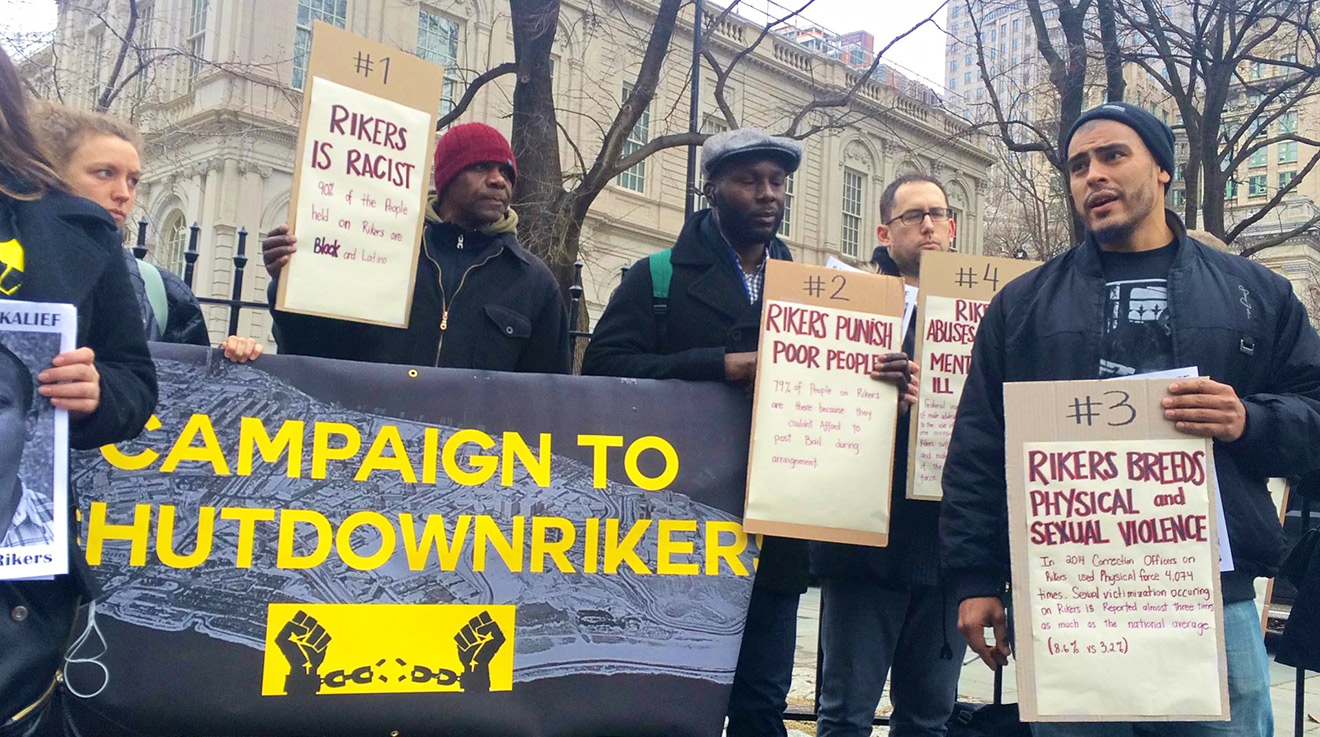
A rally by the Campaign to Shut Down Rikers.Ashoka Jegroo
For the people who were incarcerated there, their problems didn’t end when they left Rikers. In May 2015, Hailey-Means was found not guilty of the crime of which she was accused. She awaited trial, incarcerated at Rikers, for more than three years. The main reason she had to spend that long on Rikers: She couldn’t afford to pay the $500,000 bail. She’s not alone. Not being able to pay bail is a common reason people remain at Rikers.
Since she’s been released, Hailey-Means has had trouble finding a permanent place to live. She’s moved from shelter to shelter. In December 2015, she had no choice but to sleep on the subway trains for a few weeks. When I spoke to her on Feb. 25, 2016, she was living in housing provided by a mental health and drug treatment program. (She gets treated for a mental illness, but does not have a drug problem.) A couple days later, she left after an altercation, and began sleeping in the city’s subway trains again. “It’s better [this] way. I’d really rather sleep on the train than be there,” she told me. “That place just reminded me so much of jail … See one thing with jail — I couldn’t walk away. I couldn’t say, ‘you know what? I’m out of here.’ At least, that’s the positive side now; I can leave.”
“Rikers should definitely be shut down,” she added. Before Hailey-Means was arrested she was a teacher in a learning center and had her own apartment. Now, struggling to find housing, let alone a job, Hailey-Means believes the conditions that people live through once they get out makes it hard to keep them out.
Since Gerald R. has been out he’s had difficulty landing meaningful work. He’s been declined or fired for his past incarceration. He’s also struggled to adjust mentally. “I was one of the most loving people in the world before I went to Rikers,” he says. But now: “I haven’t been the same. I feel it. I know me and I know when I’m not right.” He’s lost friendships that he now mourns, gets into arguments with loved ones, and has trouble trusting people. Despite thinking for a long time that he didn’t need therapy, he admits his mental health has worsened.
Neither Gerald R. nor Hailey-Means can seem to escape what they experienced on Rikers Island.

